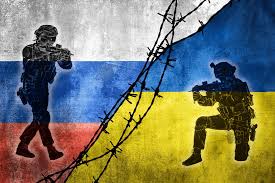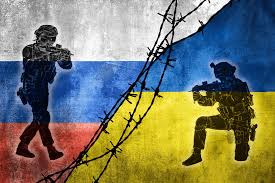
Defence analysts generally projected that the battle would end in a stalemate in 2024, with neither side gaining or losing a sizable amount of territory, prior to the two-year anniversary of Russia's war against Ukraine.
However, in just a few months of the year, Moscow has been able to crush Ukraine's defences and advance thanks to its overwhelming force of soldiers and weapons, especially in eastern Ukraine, where it has just taken control of the industrial city of Avdiivka as well as several smaller settlements.
Due to Russia's recent gains, continued concerns about Ukraine's lack of weapons and ammunition, and the suspension of U.S. military assistance, there is growing fear that a standoff may be the "best-case scenario" for Kyiv this year.
According to a defence expert, at worst, Russia might breach Ukraine's defensive lines along some of the front line.
"With Western aid stalling, Russia is intensifying its attack on Ukraine, making the upcoming months crucial to the course of the conflict." Parts of Kyiv's front line would potentially collapse in the worst case scenario, according to a March research by Ben Barry, senior fellow for Land Warfare at the IISS defence and security think tank.
The author highlighted that Russia's conquest of Avdiivka and subsequent territorial gains raise doubts about the accuracy of the Ukrainian assessment from late 2023, which predicted a stalemate in 2024.
“Moscow’s willingness to take territory in the face of high casualty figures, coupled with a boost in output of artillery shells, is in contrast with a lack of sustained Western supply of artillery ammunition to Kyiv. Those dynamics have created the conditions for the most recent shift in the land-campaign’s momentum as the third year of fighting in Russia’s full-scale invasion sets in,” he noted.
Volodymyr Zelenskyy, the president of Ukraine, has previously issued a warning that Russia intends to begin new offensives in the early summer, which makes the country's scarcity of weapons and ammunition urgent.
In especially in Donetsk and Luhansk in eastern Ukraine, Barry predicted that Russia will launch a number of significant attacks throughout the spring and summer with the intention of "inflicting Ukrainian casualties, pushing defenders westward and expanding its control of occupied territories."
Russia has already mobilised several hundred thousand personnel, thus the IISS estimated that the country can maintain an offensive campaign for a while.
“Moscow has been able to bring on enough contract soldiers to sustain its force structure and should be able to replenish tank losses on the battlefield for two or more years. It also has put its economy in a war setting, with total military spending now representing one-third of its national budget and reaching about 7.5% of GDP,” Barry noted.
According to him, the balance of weaponry against Ukraine is shifted by the supply of ballistic missiles, loitering munitions, and artillery ammunition from North Korea and Iran. Despite ample evidence of both countries' one-way attack drones and missiles, Iran and North Korea deny having any military dealings with Russia.
“That means that over the coming year Russia will probably be able to generate sufficient missiles and drones to maintain its recent level of pressure on Ukraine’s air defences, attack its defence industry and attempt to erode Ukrainian civilian and military morale,” Barry warned.
According to him, the balance of weaponry against Ukraine is shifted by the supply of ballistic missiles, loitering munitions, and artillery ammunition from North Korea and Iran. Despite ample evidence of both countries' one-way attack drones and missiles, Iran and North Korea deny having any military dealings with Russia.
“International support for Ukraine is ramping back up,” Ian Bremmer, founder and president of the Eurasia Group, said.
“That’s a big deal for Ukrainian capabilities and morale, together with Ukraine’s own additional troop mobilization (focused on bringing down the draft age below the present 27) which is likely to come in the next week or two.”
He continued by saying that these elements follow some "near-term wins" from Oleksandr Syrskyi, the head of Ukraine's armed forces.
“Syrskyi is focused on shoring up defenses, not risking troops to try to retake territory, while displaying Ukrainian capabilities to threaten Russia directly, most recently including strikes against Russian oil refineries across the country,” Bremmer noted.
“Ukraine’s future still hinges on U.S. elections in November and, longer term, asymmetries in Ukrainian military capabilities. But for now, the Ukrainians have bought themselves a little breathing space.”
(Source:www.cnbc.com)
However, in just a few months of the year, Moscow has been able to crush Ukraine's defences and advance thanks to its overwhelming force of soldiers and weapons, especially in eastern Ukraine, where it has just taken control of the industrial city of Avdiivka as well as several smaller settlements.
Due to Russia's recent gains, continued concerns about Ukraine's lack of weapons and ammunition, and the suspension of U.S. military assistance, there is growing fear that a standoff may be the "best-case scenario" for Kyiv this year.
According to a defence expert, at worst, Russia might breach Ukraine's defensive lines along some of the front line.
"With Western aid stalling, Russia is intensifying its attack on Ukraine, making the upcoming months crucial to the course of the conflict." Parts of Kyiv's front line would potentially collapse in the worst case scenario, according to a March research by Ben Barry, senior fellow for Land Warfare at the IISS defence and security think tank.
The author highlighted that Russia's conquest of Avdiivka and subsequent territorial gains raise doubts about the accuracy of the Ukrainian assessment from late 2023, which predicted a stalemate in 2024.
“Moscow’s willingness to take territory in the face of high casualty figures, coupled with a boost in output of artillery shells, is in contrast with a lack of sustained Western supply of artillery ammunition to Kyiv. Those dynamics have created the conditions for the most recent shift in the land-campaign’s momentum as the third year of fighting in Russia’s full-scale invasion sets in,” he noted.
Volodymyr Zelenskyy, the president of Ukraine, has previously issued a warning that Russia intends to begin new offensives in the early summer, which makes the country's scarcity of weapons and ammunition urgent.
In especially in Donetsk and Luhansk in eastern Ukraine, Barry predicted that Russia will launch a number of significant attacks throughout the spring and summer with the intention of "inflicting Ukrainian casualties, pushing defenders westward and expanding its control of occupied territories."
Russia has already mobilised several hundred thousand personnel, thus the IISS estimated that the country can maintain an offensive campaign for a while.
“Moscow has been able to bring on enough contract soldiers to sustain its force structure and should be able to replenish tank losses on the battlefield for two or more years. It also has put its economy in a war setting, with total military spending now representing one-third of its national budget and reaching about 7.5% of GDP,” Barry noted.
According to him, the balance of weaponry against Ukraine is shifted by the supply of ballistic missiles, loitering munitions, and artillery ammunition from North Korea and Iran. Despite ample evidence of both countries' one-way attack drones and missiles, Iran and North Korea deny having any military dealings with Russia.
“That means that over the coming year Russia will probably be able to generate sufficient missiles and drones to maintain its recent level of pressure on Ukraine’s air defences, attack its defence industry and attempt to erode Ukrainian civilian and military morale,” Barry warned.
According to him, the balance of weaponry against Ukraine is shifted by the supply of ballistic missiles, loitering munitions, and artillery ammunition from North Korea and Iran. Despite ample evidence of both countries' one-way attack drones and missiles, Iran and North Korea deny having any military dealings with Russia.
“International support for Ukraine is ramping back up,” Ian Bremmer, founder and president of the Eurasia Group, said.
“That’s a big deal for Ukrainian capabilities and morale, together with Ukraine’s own additional troop mobilization (focused on bringing down the draft age below the present 27) which is likely to come in the next week or two.”
He continued by saying that these elements follow some "near-term wins" from Oleksandr Syrskyi, the head of Ukraine's armed forces.
“Syrskyi is focused on shoring up defenses, not risking troops to try to retake territory, while displaying Ukrainian capabilities to threaten Russia directly, most recently including strikes against Russian oil refineries across the country,” Bremmer noted.
“Ukraine’s future still hinges on U.S. elections in November and, longer term, asymmetries in Ukrainian military capabilities. But for now, the Ukrainians have bought themselves a little breathing space.”
(Source:www.cnbc.com)





